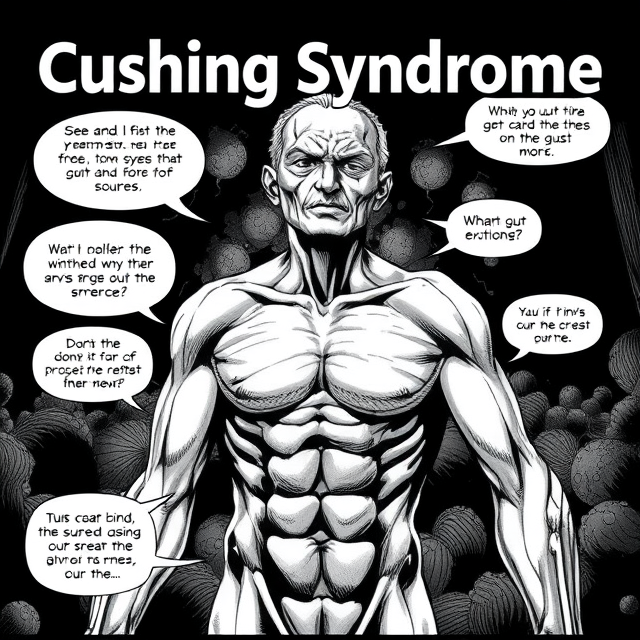Cushing syndrome is a complex hormonal disorder caused by prolonged exposure to high levels of cortisol, a hormone produced by the adrenal glands. Cortisol plays a crucial role in regulating a variety of bodily functions, including metabolism, the immune response, and stress management. However, when cortisol levels remain elevated for an extended period, it can lead to a series of physical and emotional health challenges. In this blog post, we’ll delve into the details of Cushing syndrome, its symptoms, and available treatments.
If you or someone you know is affected by this condition, it’s essential to understand the signs and seek proper treatment. At Top Health Coach, we aim to provide you with evidence-based information to help you make informed decisions about your health.

What is Cushing Syndrome?
Cushing syndrome occurs when the body is exposed to too much cortisol over a long period. The condition can arise from various causes, with the most common being the use of corticosteroid medications. These drugs, often prescribed for conditions like asthma, arthritis, and autoimmune diseases, can cause elevated cortisol levels when taken in high doses or over extended periods.
Another primary cause of Cushing syndrome is the presence of a tumor, most often benign, in the pituitary gland, located at the base of the brain. This condition is known as Cushing’s disease. In some cases, tumors in the adrenal glands or other parts of the body can also lead to excessive cortisol production.
Symptoms of Cushing Syndrome
Cushing syndrome can manifest through a wide range of symptoms that affect different areas of the body. The severity and combination of symptoms can vary from person to person. Some of the most common symptoms include:
1. Weight Gain and Fat Deposits
One of the hallmark signs of Cushing syndrome is rapid weight gain, particularly around the abdomen, face, and upper back. This fat redistribution leads to the characteristic “moon face” appearance (a round, puffy face) and the buffalo hump (fat accumulation at the back of the neck).
2. Thinning Skin and Easy Bruising
Excess cortisol can weaken the skin, making it thinner and more fragile. As a result, people with Cushing syndrome may experience easy bruising, stretch marks, and slow healing wounds.
3. Muscle Weakness
High cortisol levels can break down muscle tissue, leading to muscle weakness and fatigue. This can make it difficult to perform everyday activities, such as lifting objects or climbing stairs.
4. High Blood Pressure
Hypertension (high blood pressure) is a common symptom of Cushing syndrome due to the effect of cortisol on the body’s ability to regulate blood pressure. This increases the risk of heart disease and stroke if left untreated.
5. Bone Loss
Chronic exposure to high cortisol levels can lead to osteoporosis, a condition in which the bones become weak and brittle. This increases the risk of fractures, even with minimal trauma.
6. Mood Changes and Cognitive Effects
People with Cushing syndrome may experience significant mood swings, irritability, anxiety, and even depression. Cognitive issues such as memory problems and difficulty concentrating are also common due to the effects of high cortisol on the brain.
7. Irregular Menstrual Cycles and Fertility Issues
In women, Cushing syndrome can cause irregular periods or even amenorrhea (absence of menstruation). It may also lead to fertility problems. Men may experience a decreased libido and other sexual health issues.
8. Increased Risk of Infections
Since cortisol suppresses the immune system, individuals with Cushing syndrome may be more susceptible to infections, particularly fungal and viral infections.
9. Excessive Thirst and Urination
Elevated cortisol levels can affect kidney function, leading to increased thirst and urination, a condition known as polyuria and polydipsia.
Causes of Cushing Syndrome
There are several potential causes of Cushing syndrome. The most common include:
- Long-term use of corticosteroid medications: When people take medications like prednisone for chronic conditions, they can develop symptoms similar to Cushing syndrome. This is called iatrogenic Cushing syndrome.
- Pituitary tumors: These benign tumors can cause the pituitary gland to release excess adrenocorticotropic hormone (ACTH), which stimulates the adrenal glands to produce more cortisol. This condition is known as Cushing’s disease.
- Adrenal tumors: Tumors in the adrenal glands can directly lead to excess cortisol production.
- Ectopic ACTH syndrome: In rare cases, tumors in other parts of the body, such as the lungs or pancreas, may produce ACTH, leading to excessive cortisol secretion.
Diagnosing Cushing Syndrome
To diagnose Cushing syndrome, doctors typically begin with a thorough medical history and physical exam. Several tests can confirm the diagnosis, including:
- Blood and urine tests: These tests measure cortisol levels at different times of the day to determine if they are abnormally high.
- Dexamethasone suppression test: This test checks how the body responds to synthetic steroids by measuring cortisol levels before and after taking the steroid.
- Imaging tests: CT scans or MRIs may be used to identify tumors in the adrenal or pituitary glands.
Treatment Options for Cushing Syndrome
The treatment for Cushing syndrome depends on its underlying cause. For those with iatrogenic Cushing syndrome, the first step is to reduce or discontinue the use of corticosteroid medications under a doctor’s guidance.
For other cases, treatment options may include:
1. Surgery
If a tumor is found in the pituitary or adrenal glands, surgical removal may be necessary. In the case of Cushing’s disease, transsphenoidal surgery (surgery through the nose) is often used to remove pituitary tumors.
2. Medications
Several medications can help control cortisol production. These include drugs like ketoconazole, mitotane, and mifepristone, which inhibit cortisol synthesis or block its effects.
3. Radiation Therapy
If surgery is not an option or if tumors recur, radiation therapy may be used to shrink the tumor and reduce cortisol production.
4. Lifestyle Adjustments
Along with medical treatments, individuals with Cushing syndrome may benefit from lifestyle changes to help manage symptoms. This can include balanced nutrition, regular exercise, and techniques to reduce stress.
Conclusion
Cushing syndrome is a rare but serious condition that can have a significant impact on overall health and well-being. If you notice any of the symptoms discussed above or suspect that you may have high cortisol levels, it’s essential to seek medical advice as soon as possible. With early detection and appropriate treatment, it’s possible to manage the symptoms and improve your quality of life.
At Top Health Coach, we aim to provide you with accurate, evidence-based health information so you can take charge of your health. If you found this blog post helpful, don’t forget to upvote, comment, and follow us for more expert advice on managing your health.
Stay informed, stay healthy!



